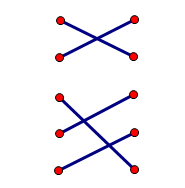题意:这题自己YY了下,没想到结论还是对的。题目告诉我们一个有向图,现在问将图中的每一个点都划分到一个环中的最少代价是多少?每条边都有一个代价。
解法:由于要成环,那么将这个图进行拆点,就变成了单向的二分图了,此时一个完备匹配就是一种连线策略,只要保证没有边是和自己相连,就能够满足题目中要求的每个点至少属于一个环。证明也是很简单的。因为我们总可以从一个完备匹配中找出起点,然后再从匹配点作为起点找......
 左图可以看做是1,2成环,3,4,5成环。
左图可以看做是1,2成环,3,4,5成环。
代码如下:
#include <cstdlib> #include <cstring> #include <cstdio> #include <iostream> #include <algorithm> using namespace std; int N, M; const int INF = 0x3f3f3f3f; int w[205][205]; int lx[205], ly[205]; int sx[205], sy[205]; int match[205], slack[205]; int path(int u) { sx[u] = 1; for (int i = 1; i <= N; ++i) { if (sy[i]) continue; int t = lx[u] + ly[i] - w[u][i]; if (!t) { sy[i] = 1; if (!match[i] || path(match[i])) { match[i] = u; return true; } } else { slack[i] = min(slack[i], t); } } return false; } void KM() { memset(match, 0, sizeof (match)); memset(lx, 0x80, sizeof (lx)); memset(ly, 0, sizeof (ly)); for (int i = 1; i <= N; ++i) { for (int j = 1; j <= N; ++j) { lx[i] = max(lx[i], w[i][j]); } } for (int i = 1; i <= N; ++i) { memset(slack, 0x3f, sizeof (slack)); while (1) { memset(sx, 0, sizeof (sx)); memset(sy, 0, sizeof (sy)); if (path(i)) break; int d = INF; for (int j = 1; j <= N; ++j) { if (!sy[j]) d = min(d, slack[j]); } for (int j = 1; j <= N; ++j) { if (sx[j]) lx[j] -= d; if (sy[j]) ly[j] += d; else slack[j] -= d; } } } int ret = 0; for (int i = 1; i <= N; ++i) { ret += w[match[i]][i]; } printf("%d\n", -ret); } int main() { int T, x, y, ct; scanf("%d", &T); while (T--) { scanf("%d %d", &N, &M); memset(w, 0x80, sizeof (w)); for (int i = 1; i <= M; ++i) { scanf("%d %d %d", &x, &y, &ct); w[x][y] = max(w[x][y], -ct); } KM(); } return 0; }